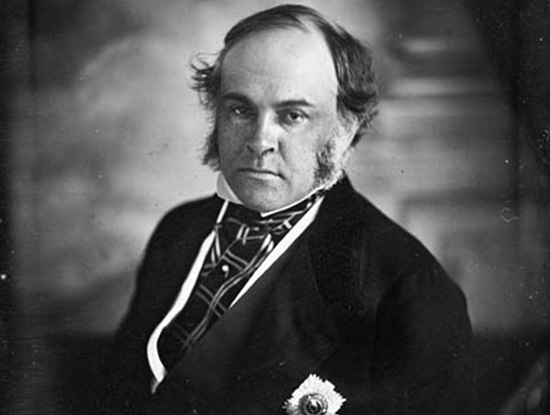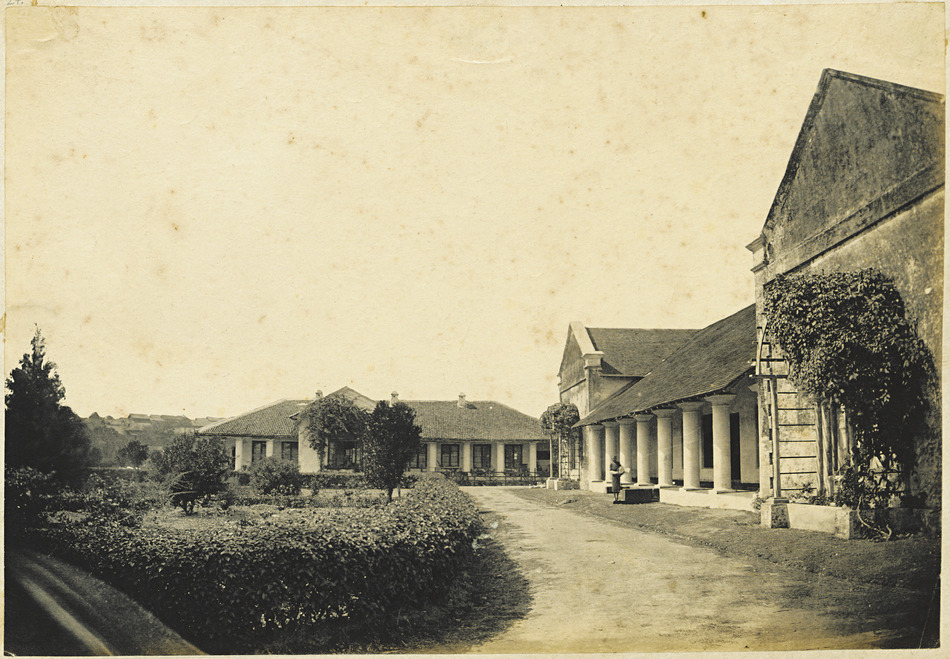Featured Image: Photo of Coluvanda Family. Image Credits: Ainmanes.com / Boverianda Chinnappa & Nanjamma. Probably 19th Century.
Under the Haleri Kings of Kodagu, Kodavas were the aristocracy, civil and military administrators of the land. Lt. Connor, who surveyed Kodagu during King Lingarajendra II’s rule, noted that “every place of responsibility in Kodagu, was held by the Kodavas” .
Kannada being the mother tongue of the Haleri Kings, with it’s own script and also being a primary mode of communication with other communities in Coorg and the Mysore kingdom, was used as the language of the court, aristocracy, administration and record-keeping.
Kodava children were schooled by the Haleri Kings. A royal edict issued in 1828 by Chikka Vira Rajendra, the last king of Kodagu, ordered local officers of each Nad (administrative zone) to “prepare a list of all Kodava boys who were both strong and intelligent so that they may be trained for Government services in which they are needed.”
When Kodagu came under British Administration, Kannada continued as the administrative language in Kodagu as the Kodavas in the administration knew only to read and write in Kannada. Such schools did exist and the Kodavas who remained as aristocrats and administrators under the British, continued to communicate for official purposes in Kannada with them, which was translated in English or Persian by government translators, to be read by the British officials.
Though Mercara English School(Anglo-vernacular) existed since 1834, the Kodavas did not feel the need to educate their children in English, some also feared that the Mercara English School was built for the purpose of converting their children to Christianity. Nonetheless, one Kodava, Coluvanda Cariappa, braved the opposition of other Kodavas, joined the Mercara English School, and reached a very high position in Coorg administration.
Later, English also became an official language of administration in Coorg, but was restricted for communication between the English officials. With the influx of English Planters in Kodagu, the Kodava Chiefs foresaw the importance of educating their children in English, so that they can communicate and compete better with their English counterparts.
Their determination, planning and execution was meticulous. They also donated generously to see it through.

On 26th August, 1862, a petition was submitted to Superintendent of Coorg, John Campbell, which travelled through bureaucratic channels and reached Governor General, Lord Elgin(James Bruce).
The petition from the Headmen of Coorg, was written in English by Coluvanda Cariappa and signed by 65 Headmen and Officials of Coorg, 64 of them signed in Kannada, Coluvanda Cariappa signed it in English. The petition was an earnest request to start a new English boarding School for Boys and Girls at Madikeri. As most of the Kodavas used to stay far away from Madikeri town, it was decided that the new school with a boarding house would serve the purpose. The Kodava officials and pensioners were ready to donate half of their monthly salary/pension for the purpose, which came up to Rs 6000. For the rest they requested the Government to sell the Mercara English School building and grant the balance funds for the construction of the new school and boarding house at Madikeri. Their estimated budget for the School and boarding houses for girls and boys was 20,000.

Lord Elgin granted the petition in 1863 and sanctioned the balance requested – Rs 11,000 towards its construction. But, inflation had kicked in. The cost of building the School & Boys Boarding School came up to Rs 32,548, towards which the Kodavas donated Rs 9,721 , Europeans in Kodagu donated Rs 471, from the sale of the old school building, Rs 6,500 was generated. The remaining balance for construction was paid from Government treasury. This school came to be known as Mercara Central School.
34 Schools with Kannada as the medium of instruction, continued to exist in different Nads of Coorg and were well attended, nearly all the masters in these Kannada schools were Kodavas.

The boarding house for the girls.
With no possibility of further funding coming from the Government or Kodavas, for girls boarding house, Coluvanda Cariappa, the Subedar of Madikeri taluk – stepped forward and built the Mercara boarding house for girls with his money, with support from his friend Cheppudira Subbaiah.

For the School’s endowment, Coluvanda Cariappa donated 301 Acres to establish a coffee plantation and to utilize the profits from the plantation for the school’s maintenance. The Commissioner waived off the gift tax on it. Other Kodavas loaned money to start the plantation. This plantation came to be known as “School Estate”, where the School’s headmaster Reverend Richter, resided.

Many Kodavas who studied in the Central School, found employment in Coorg, Mysore and other parts of India. Field Marshal Cariappa is one of the famous alumni’s of Central School.
The school also benefited other communities in Kodagu, as admission was open to all the communities, irrespective of their caste or religion.
I can’t agree more with Muthanna’s comment in the previous article, where he says that “foresight and impetus” has considerably reduced. Unfortunately, even when Coorg was a separate state – our elected representatives, most of whom were Kodavas, didn’t even think of starting a University on the lines of Mysore University, which was started in 1916.
After losing statehood, Kodagu’s fate was sealed. Children of Kodavas and other communities had to migrate to acquire higher education. They still do.
As Muthanna pointed out – Coorg Education Fund and other Kodavas who have the capacity and resources, can make it happen. As Muthanna aptly said – Surely the same foresight demonstrated by our elders a century ago can be recreated.



My father and I studied at Surlabbi School which is now more than a century old. Serious minded students went to High School at Somwarpet but it is not feasible for most from this area. We work hard, make sacrifices and send our children outside the district for higher education in English medium – that’s where their future is secure.
Basic infrastructure was lacking with very little development. Our demands fell on deaf ears. We had to trudge to Madikeri on foot during our youth for higher education. Things haven’t changed.
There are a few members of our Okka who have done exceptionally well after their primary education at Surlabbi , but that is uncommon.
There are a few who have pursued higher education in English medium and gone on to excel in prestigious private organizations as Engineers and also also in the education field of education.
At Garvale, Surlabbi, Mutlu, Hammiyala, Mukkodlu, Kalur – the lament is the same. Lack of basic infrastructure, educational facilities, healthcare…has forced them to migrate to places with better facilities. It is not surprising that a disproportionate number of men have secured jobs with Security Companies in Bangalore and Mysore as Gun men and their absence makes it unsafe for those who are forced to stay back at home – especially the aged.
Sadly, there are disproportionate reports of criminal activity, and it is generally considered unsafe areas.
Large tracts of centuries old ancestral properties have found buyers from outside the district – in an environmentally sensitive zone, at relatively low prices. The area is in a state of flux. These areas were considered as old Kodava heartland where the culture was preserved with pride. As the elders move on, this too is in imminent danger of getting marginalised. Almost all of them are very guarded in speaking of the lack of political will to develop these areas.
It’s a poor reflection on us Kodavas that despite being the first in establishing formal schools of education in English, even before Mysore and Mangalore, we do not have adequate institutions of higher learning barring CIT Ponnampet.
Mangalore and surrounding areas in Tulunad have shown exemplary private enterprise in higher education in every field – basic Graduate studies (BA, BSc, BCom), Medicine, Engineering (in all fields), Law, Business Administration, Hotel Management, Teachers Training, Nursing…. the list is endless. As a consequence Tulunad has prospered in every field with distinction.
If we cannot attract private enterprise in the field of higher education to the district, the departure of youngsters to pursue higher education away from their home base will continue to happen.
The Coffeeland articles are really good!
If Mercara English School had existed in 1834, then it predates the establishment of schools in Mangalore (BEM School, 1836/1838) and Mysore (Hardwicke School, 1839/1840). Interesting!
Most Government Schools have failed due to paucity of students because medium of instruction is in Kannada and not in English. The same is with Bettageri High school where the Kannada section has no students, but the English medium is full.
Waow! Really genius information. Hats off to our ancestors foresight
What a wonderful gesture by our ancestors we are really lucky let us try to pass it on to younger generation.
Hats off to our elders for their immense foresight and inspiring generosity. We owe it to them for us today being a community that is known for its qualitative presence in every sphere. Time to resurrect the schools started/built by our forefathers…
Well researched, informative and well presented. Need more such articles highlighting our rich Legacies, yomen Services & Sacrifices of our Elders in their Quest for preserving & protecting our rich tradition and culture, 👍👍